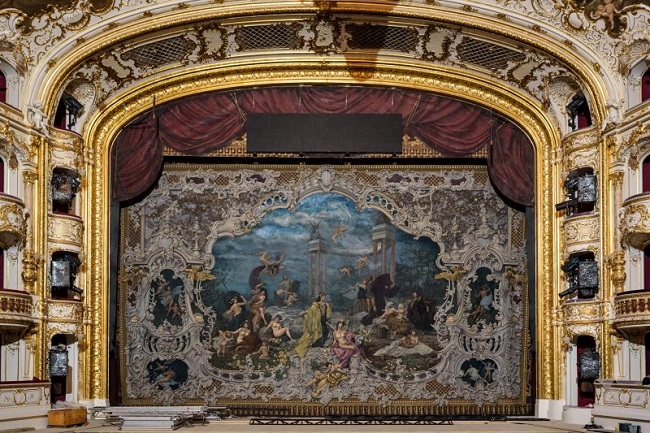
The State Opera was built by the Germans of Prague; the Czechs took it over after the war
 |
Prague - A selection of information about the State Opera in Prague, which will reopen on January 5 after a nearly three-year reconstruction:
- The building, which currently houses the State Opera - since 2012 one of the four stages of the National Theatre - was built at the end of the 19th century by the Prague German Theater Society. The majestic theater, now squeezed between two streams of the north-south boulevard, is a typical example of the architecture of Vienna builders Ferdinand Fellner and Hermann Helmer, who also collaborated with the author of the Vienna Burgtheater, Karl Hasenauer. The New German Theater welcomed its first audience on January 5, 1888.
- However, theater performances took place at the site of today's State Opera earlier, in a wooden building of the New Town Theater, where from the late 1850s, alternating Czech (afternoon) and German (evening) productions were presented. The stage, originally located beyond the city walls, hosted celebrations of the 300th anniversary of the birth of William Shakespeare in 1864, and in May 1868, it premiered Smetana's opera Dalibor on the day of the laying of the foundation stone for the National Theatre. The gradually dilapidated building continued to host performances until 1885 when it was demolished.
- The New German Theater (Neues Deutsches Theater) quickly established itself as a cultural institution of international significance from its opening, which was marked by Wagner's Die Meistersinger von Nürnberg. The first director, Angelo Neumann, originally a singer, gave this stage its profile and artistic level. He managed to gather outstanding conductors, opera singers, and fine actors around him. He invited ensembles from all over the world, with the theater shining due to the presence of the best guests, including Enrico Caruso and Eleonora Duse.
- After Neumann's death in 1910, several personalities took the helm of the theater located on the grounds of the former Smetanka estate garden. His successor, Heinrich Teweles, was fortunate to call Alexander Zemlinsky to Prague, who made Prague one of the world's centers of operatic art as the head of the opera from 1911 to 1927. His era was marked as a direct continuation of the most famous segment of the Vienna Court Opera under the direction of Gustav Mahler.
- During the First Republic, the theater premiered works such as Arnold Schönberg's monodrama Erwartung (1924), Ernst Křenek's opera Jonny spielt auf (1927), or Hans Krása's Pralinka (1933). The golden era of the German stage, where renowned presidents Masaryk and Beneš attended performances and where many artists fleeing from Hitler found refuge in the 1930s, came to an end in September 1938. During the occupation, the theater did not have regular performances, only occasionally hosting some German ensembles and Nazi gatherings.
- After the liberation, the building was handed over to the newly established Theatre of May 5, whose opera section introduced Smetana's opera The Brandenburgers in Bohemia in September 1945. The updated production directed by Václav Kašlík took place on a stage designed with a large swastika and significantly differed from the classic interpretation presented at that time by the National Theatre (ND). The theater, which operated as an independent May 5 Grand Opera from 1946, did not survive the year 1948 when it was transferred under the ND.
- "The merger with the May 5 Grand Opera brought the National Theatre into a latent state of crisis. The National Theatre could not digest this merger for a full 40 years," commented the then director of the ND, Jindřich Černý, on the connection even in 1990. In the building, renamed to Smetana Theatre, primarily major operatic and ballet titles from the world repertoire were performed, and many foreign ensembles also guest-starred here. At the turn of the 1960s and 1970s, the theater underwent a significant reconstruction.
- A new era for the State Opera began in 1992, when the local opera (and also ballet) company became independent and, under its own management and with its own dramaturgy, became a strong competitor to the opera of the National Theatre. The revival of the tradition of Balls in the Opera, the first of which was held in February 1992 under the auspices of the ND, also contributed to the prestige of the State Opera Prague. This two-decade-long era ended at the beginning of 2012 when, despite protests from some artists and the public, the State Opera was merged again with the National Theatre.
- In July 2016, the opera closed for more than three years due to extensive renovations, which began in March 2017. During it, it received new stage technologies, modern rehearsal rooms, and repairs were made to the ballet, orchestral, and choir halls, as well as the artists' facilities. Seats with individual subtitle devices were added. The building, whose repairs cost 1.3 billion crowns, will now be opened with an opera concert titled The State Opera in Transformations of Time (1888-2018) directed by Alice Nellis.
The English translation is powered by AI tool. Switch to Czech to view the original text source.
1 comment
add comment
Subject
Author
Date
Něco vypadlo
raval
02.01.20 10:06
show all comments
Related articles
0
04.01.2021 | The State Opera Prague was founded in 1888 as the New German Theatre
0
17.10.2017 | In the State Opera, demolition is ceasing, repairs will last for two years
0
13.03.2017 | The leadership of the ND will symbolically inaugurate the reconstruction of the State Opera in Prague
0
20.02.2017 | <State opera can be repaired, the UOHS rejected the complaint>
0
30.01.2017 | In the tender for the repair of the State Opera, Metrostav appealed to the Office for the Protection of Competition
1
21.07.2016 | Interest in repairing the State Opera for a billion has seven bidders
0
30.01.2015 | The reconstruction of the State Opera building will cost 715 million crowns












